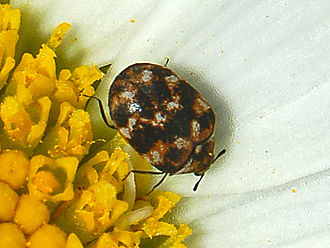Varied carpet beetle

The varied carpet beetle (Anthrenus verbasci) is a 3 mm-long beetle belonging to the family Dermestidae. They are a common species, often considered a pest of domestic houses and, particularly, natural history museums, where the larvae may damage natural fibers and can damage carpets, furniture, clothing, and insect collections. A. verbasci was also the first insect to be shown to have an annual behavioral rhythm[1] and to date remains a classic example of circannual cycles in animals.
Adult A. verbasci range in length from 1.7 to 3.5 mm (0.07 to 0.14 in). The body is rounded, almost spherical. The elytra and pronotum are covered in fine scales of different colours, creating an irregular pattern of white, brownish and yellowish patches on these features. The white scales are focussed along the lateral margins of the pronotum and on the elytra, where they form three bright, wavy transverse bands. In addition to these morphological features, their antennae are 11-segmented, with a club of 3 segments.[2]
The larval form of A. verbasci, commonly known as ‘woolly bears’ (a name shared with the larvae of Arctia caja and many other moths of the subfamily Arctiinae), measures up to 4–5 millimetres (0.16–0.20 in) in length. The larvae are elongated and densely covered in large setae (hairs). These hairs are organised into alternating, transverse groups of light and dark-brown patches: the larva appears covered in brown stripes. The body is usually wider at the back than at the front where it also bears 3 pairs of hair tufts along its rear abdomen that can be used for self-defense.[3]
Life cycle
Larva of A. verbasci. Front view
A. verbasci has a life cycle ranging from 1–3 years, depending upon the environmental conditions. A study in 1958 found that temperature is able to affect larval development, concluding that the periods of incubation and pupation of A. verbasci decrease with increase of temperature (the life cycle is thus quickened with a moderate rise in temperature). Incubation decreased from 54 days at 15 °C to 12 days at 30 °C, and the pupation decreased from 89 days at 10 °C to 9 days at 25 °C. Relative humidity was shown to have little effect.[4]
Larvae hatch from eggs in the spring and early summer, often in the nests of birds (including those of the house sparrow and house swift) or around stored fabrics.[5]
Adults emerge between late May and early August (in England), flying to and feeding on the pollen and nectar of flowering plants.[6][7] The life expectancy of the beetle is about two weeks. During this period, mating occurs and the eggs are laid, either close to the human environs or in bird nests, tree hollows and similar, dry places where larvae can find their food. Then the cycle begins anew.
Larvae feed on keratin and chitin of natural fibers (dead insects, animal hair and feathers) throughout their development, eventually experiencing a dormancy period (also known as diapause) prior to pupation into the adult stage. The length of the dormancy appears to depend on environmental factors, with the most likely zeitgeber being photoperiod.[5] Adults feed on the pollen and nectar of flowering plants.[7]
